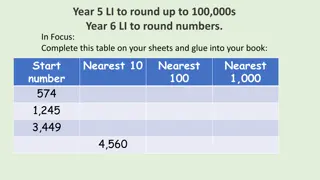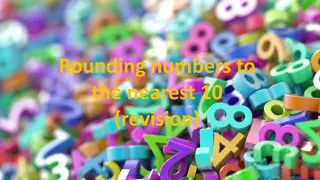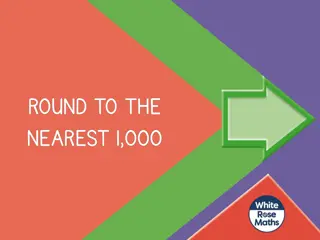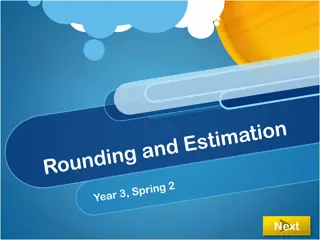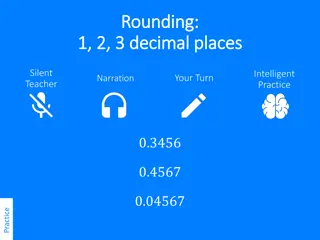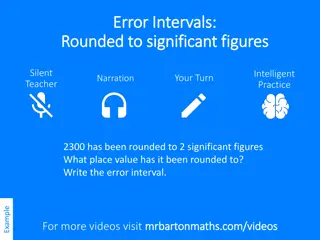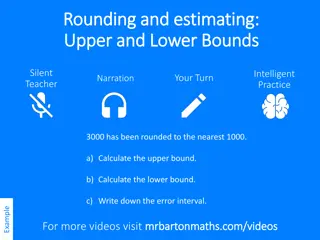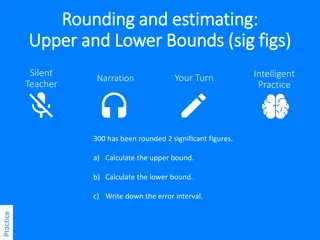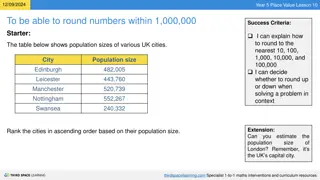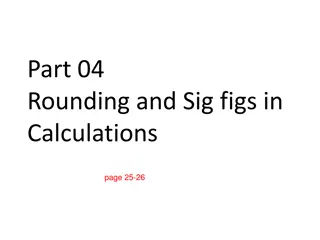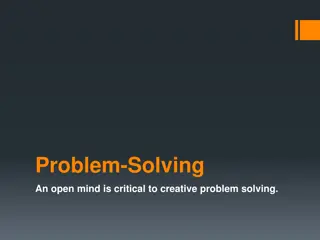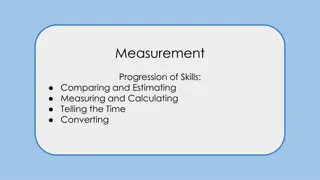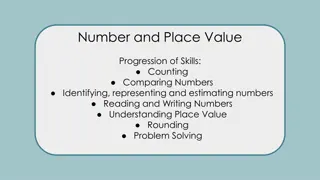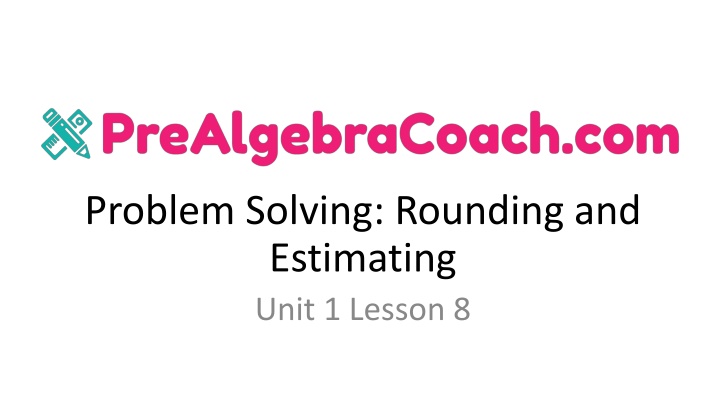
Problem-Solving: Rounding and Estimating Strategies
Explore the concept of rounding numbers to make them easier to work with. Learn the rules for rounding, identify place values, and practice rounding to the nearest ten and hundred in this guided lesson on problem-solving.
Download Presentation

Please find below an Image/Link to download the presentation.
The content on the website is provided AS IS for your information and personal use only. It may not be sold, licensed, or shared on other websites without obtaining consent from the author. If you encounter any issues during the download, it is possible that the publisher has removed the file from their server.
You are allowed to download the files provided on this website for personal or commercial use, subject to the condition that they are used lawfully. All files are the property of their respective owners.
The content on the website is provided AS IS for your information and personal use only. It may not be sold, licensed, or shared on other websites without obtaining consent from the author.
E N D
Presentation Transcript
Problem Solving: Rounding and Estimating Unit 1 Lesson 8
Problem Solving: Rounding and Estimating Students will be able to: Round numbers Apply estimation strategies Key Vocabulary: Rounding Estimating Digit Cluster
Problem Solving: Rounding and Estimating Rounding is a way of simplifying numbers to make them easier to understand or work with them. Rounding can be used when an exact number isn't needed, and an approximate answer will do.
Problem Solving: Rounding and Estimating Rules for Rounding The rules for rounding are simple, and should make sense if you understand what rounding is.
Problem Solving: Rounding and Estimating Step 1 Identify the place value of the digit you want to round. Step 2 If the digit to the right of the identified digit is 5 or more (5, 6, 7, 8, 9), increase the identified digit by 1. If the digit to the right is less than 5 (0, 1, 2, 3, 4), do not change the identified digit. Step 3 Change all digits to the right of the rounded identified digit to zeros.
Problem Solving: Rounding and Estimating Sample Problem 1: Round the following numbers. ??? a. Nearest ten
Problem Solving: Rounding and Estimating Sample Problem 1: Round the following numbers. a. ?? ? ??? To round ??? to the nearest ten, observe that the digit in the ones place is?. Since this digit is less than 5, we do not add 1 to the digit in the tens place. The number ??? rounded to the nearest ten is ???.
Problem Solving: Rounding and Estimating Sample Problem 1: Round the following numbers. b. ?,???Nearest hundred
Problem Solving: Rounding and Estimating Sample Problem 1: Round the following numbers. ?,? ? ? ?,??? b. To round ?,??? to the nearest hundred, observe that the digit in the tens place is?. Since this digit is at least 5, we add 1 to the digit in the hundreds place. The number ?,??? rounded to the nearest hundred is ?,???.
Problem Solving: Rounding and Estimating Sample Problem 1: Round the following numbers. ??,??? c. Nearest thousand
Problem Solving: Rounding and Estimating Sample Problem 1: Round the following numbers. c. ??, ? ?? ??,??? To round ??,??? to the nearest thousand, observe that the digit in the hundreds place is ?. Since this digit is at least 5, we add 1 to the digit in the thousands place. The number ??,??? rounded to the nearest thousand is ??,???.
Problem Solving: Rounding and Estimating Sample Problem 1: Round the following numbers. d. ???.??Nearest tenth
Problem Solving: Rounding and Estimating Sample Problem 1: Round the following numbers. ???.? ? ???.?? d. To round ???.?? to the nearest tenth, observe that the digit in the hundredths place is ?. Since this digit is less than 5, we do not add 1 to the digit in the tenths place. The number ???.?? rounded to the nearest tenthis ???.??.
Problem Solving: Rounding and Estimating Sample Problem 1: Round the following numbers. e. ?.??? Nearest hundredth
Problem Solving: Rounding and Estimating Sample Problem 1: Round the following numbers. ?.?? ? ?.??? e. To round ?.??? to the nearest hundredth, observe that the digit in the thousandths place is?. Since this digit is at least 5, we add 1 to the digit in the hundredths place. The number ?.??? rounded to the nearest hundredth is ?.???
Problem Solving: Rounding and Estimating Using the Number Line to Round Numbers We can visualize the process of rounding by using a number line. 26 27 19 18 23 24 25 17 20 16 21 22 15
Problem Solving: Rounding and Estimating Sample Problem 2: Round the following numbers. USE NUMBER LINE a. ??? Nearest ten
Problem Solving: Rounding and Estimating Sample Problem 2: Round the following numbers. USE NUMBER LINE a. ??? ??? 260 270 190 180 230 250 240 170 200 160 210 220 150 ?? ? ???
Problem Solving: Rounding and Estimating Sample Problem 2: Round the following numbers. USE NUMBER LINE b. ?,??? Nearest hundred
Problem Solving: Rounding and Estimating Sample Problem 2: Round the following numbers. USE NUMBER LINE b. ?,??? ?,??? 1,600 1,400 1,550 1,200 1,150 1,450 1,500 1,100 1,250 1,050 1,300 1,350 1,000 ?,? ? ? ?,???
Problem Solving: Rounding and Estimating Sample Problem 2: Round the following numbers. USE NUMBER LINE c. ??.?? Nearest tenth
Problem Solving: Rounding and Estimating Sample Problem 2: Round the following numbers. USE NUMBER LINE c. ??.?? ??.?? 15.11 15.12 15.04 15.03 15.10 15.08 15.09 15.02 15.05 15.01 15.06 15.07 15.00 ??.? ? ??.??
Problem Solving: Rounding and Estimating Estimating Estimating is another way of making numbers easier to work with when we don't need to know exactly how many; we just need to know about how many. Estimation is finding a number that is close enough to the right answer.
Problem Solving: Rounding and Estimating Rounding Method Rounding is one common method used for estimating. Determine the place value to use for the particular problem you want to estimate. Now that your numbers end in zero, you can easily do mental math to solve the problem, whether that requires adding, subtracting, multiplying or dividing.
Problem Solving: Rounding and Estimating Sample Problem 3: Estimate the answer using rounding method. ?,??? + ??? = a.
Problem Solving: Rounding and Estimating Sample Problem 3: Estimate the answer using rounding method. ?,??? + ??? = Round to nearest ten a. ?,?? ? ?,??? ?? ? ??? ?,??? + ??? = ?,???
Problem Solving: Rounding and Estimating Sample Problem 3: Estimate the answer using rounding method. ?,??? ?,??? = b.
Problem Solving: Rounding and Estimating Sample Problem 3: Estimate the answer using rounding method. ?,??? ?,??? = Round to nearest hundred b. ?,? ? ? ?,??? ?,? ? ? ?,??? ?,??? ?,??? = ?,???
Problem Solving: Rounding and Estimating Sample Problem 3: Estimate the answer using rounding method. ?? ?? = c.
Problem Solving: Rounding and Estimating Sample Problem 3: Estimate the answer using rounding method. ?? ?? = Round to nearest ten c. ? ? ?? ? ? ?? ?? ?? = ???
Problem Solving: Rounding and Estimating Sample Problem 3: Estimate the answer using rounding method. ?,??? ??? = d.
Problem Solving: Rounding and Estimating Sample Problem 3: Estimate the answer using rounding method. ?,??? ??? = Round to nearest hundred d. ?,? ? ? ?,??? ? ? ? ??? ?,??? ??? = ?
Problem Solving: Rounding and Estimating Front End Estimation The name comes from the way that you round. Instead of rounding each number to a given place value, we round whatever number is in the front. With front end estimation, we only round and calculate with numbers in the leftmost place or the very last number on the left. This means that all numbers in other places will be zeros except the number in the leftmost place after the numbers are rounded.
Problem Solving: Rounding and Estimating Sample Problem 4: Estimate the answer using front end estimation. ??,??? + ??? = a.
Problem Solving: Rounding and Estimating Sample Problem 4: Estimate the answer using front end estimation. ??,??? + ??? = a. ? ? ,??? ??,??? ? ? ? ??? ??,??? + ??? = ??,???
Problem Solving: Rounding and Estimating Sample Problem 4: Estimate the answer using front end estimation. ??,??? ??,??? = b.
Problem Solving: Rounding and Estimating Sample Problem 4: Estimate the answer using front end estimation. ??,??? ??,??? = b. ? ? ,??? ??,??? ? ? ,??? ??,??? ??,??? ??,??? = ??,???
Problem Solving: Rounding and Estimating Sample Problem 4: Estimate the answer using front end estimation. ??? ??? = c.
Problem Solving: Rounding and Estimating Sample Problem 4: Estimate the answer using front end estimation. ??? ??? = c. ? ? ? ??? ? ? ? ??? ??? ??? = ??,???
Problem Solving: Rounding and Estimating Sample Problem 4: Estimate the answer using front end estimation. ?,??? ??? = d.
Problem Solving: Rounding and Estimating Sample Problem 4: Estimate the answer using front end estimation. ?,??? ??? = d. ?, ? ?? ?,??? ? ? ? ??? ?,??? ??? = ??
Problem Solving: Rounding and Estimating Cluster Estimation Cluster estimation can be used to estimate sums and products when the numbers you are adding or multiplying cluster near or is close in value to a single number.
Problem Solving: Rounding and Estimating Sample Problem 5: Estimate the answer using cluster estimation. ??? + ??? + ??? + ??? = a.
Problem Solving: Rounding and Estimating Sample Problem 5: Estimate the answer using cluster estimation. ??? + ??? + ??? + ??? = Notice that they all cluster around 400. a. ??? + ??? + ??? + ??? = ? ??? = ?,??? ???? ??????: ??? + ??? + ??? + ??? = ?,???
Problem Solving: Rounding and Estimating Sample Problem 5: Estimate the answer using cluster estimation. ?? ?? ?? ?? = b.
Problem Solving: Rounding and Estimating Sample Problem 5: Estimate the answer using cluster estimation. ?? ?? ?? ?? = Notice that they all cluster around 30. b. ?? ?? ?? ?? = ???,??? ???? ??????: ?? ?? ?? ?? = ???,???

